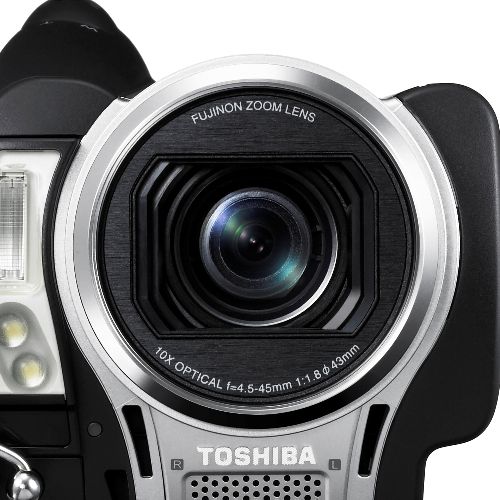With your average lounge TV growing in size, the popularity of HD camcorders is growing. Should you be interested in the Toshiba Gigashot A100FE? We get filming to find out.
Our quick take
Simplicity rules with the Gigashot. The simple point and shoot functionality is ideal for those who want to capture high-quality footage in an uncomplicated manner. The video quality is very good and so long as care is taken with the zoom, focusing should not be too much of an issue.
This is a competitive market however and those looking for more options will not have trouble finding models from Sony, JVC, Canon and others.

Toshiba Gigashot A100FE camcorder - 3.5 / 5
| FOR | AGAINST |
|---|---|
|
|
From a design point of view, the Gigashot is a familiar design, with a flip-out screen on the left and a comfortable grip for the right-hand side, sandwiching the lens body in the middle. The rubberised grip feels comfortable in the hand, with the main controls falling within reach of your thumb and fingers.
Controls are relatively simple and you are not overwhelmed with buttons, with many of the options being accessed through the screen. The screen also acts as the power on/off, which means all you have to do is flip it out and within a few seconds you can start filming. The screen is fairly good, a 3-inch 16:9 LCD with 230,000 pixels, that copes with bright conditions for filming in the summer sun. Unfortunately there is no viewfinder.
The record button sits neatly under the thumb with the 10x zoom operated by the rocker under your fingers. Here you’ll also find the shutter button for the still camera, whilst also allowing still images to be captured during filming. If this is going to be an option you take, there is a slot for your SDHC card.
There is also a power slider, if the unit should power off or when you don’t need to use the screen, and buttons for backlight compensation and the LED illuminator for capturing those Blair Witch moments. It works reasonably well, bathing the subject in white light to retaining some colour, rather than the Bravo Two Zero effect you get from many night modes. That said, some people might want to be talking in a green tinge. The Gigashot seems to like working in auto mode, so much so that there is an "auto" button that will highlight the record and zoom controls in blue and disable other functions.
Many of the options lie within the menus and more advanced users will potentially be irritated by excessive menu usage – changing the white balance for example. The menus are navigated using a rotating wheel and a four-way button, and it can be a little confusing to find what you want. You get the sense that the Gigashot is aimed at those who will use it as a "point and film" camcorder.
In terms of connectivity, you get a standard AV out, Component, USB and mini HDMI. The supplied Component cable perhaps compensates for the fact that you don’t get the HDMI in the box, which we would liked to have seen. As it is mini HDMI, your existing HDMI cables won’t fit – more’s the shame. You also get a remote control: good for playback and those who want to perform in front of the camera.
Recording at the XQ (1920 x 1080i) Full HD standard will give you about 12 hours from the 100GB hard drive shooting MPEG4 AVC/H.264. You can of course turn this down to SP and double your usage of the disk.
Video quality is actually very good, and we found that indoors and out we got good results, even from the illumination option. The Gigashot coped with moving from shadow to bright sunshine without too many problems – the rule of thumb seems to be take your time and the camera will adjust accordingly.
Focusing is often an issue and on the whole, the Gigashot copes well, however there are moments when you lose it and suddenly you’re focused on the background. This is common when using the zoom; you’ll also find that if you zoom too fast, you’ll lose focus, which is a common phenomenon.
The included stereo mic suffers from wind noise as is often the case and there are no options for external mic attachment. Equally, there is no hot shoe – the Gigashot has been designed to fly solo in this regard.
The camcorder is powered by a supplied 1200mAh Li-ion battery or directly via the 10V DC powerpack. We managed to get about 1 hour and 20 minutes straight shooting on the highest settings before the battery gave out, although this was static and didn’t include any zooming – something to bear in mind if you plan to be out and about for long.
Of course, the problem lies not in the ability to capture the content, but what you do with it at the other end. Perhaps showing its age, the manual refers to the now defunct HD DVD, and in reality, if you are planning to shoot a lot of HD content, then you need to be able to reliably store it somewhere. As an exercise in future-proofing, then yes, you can film at lower quality and wait until your other hardware catches up.
To recap
The simple point and shoot functionality of the Gigashot is ideal for those who want to capture high-quality footage in an uncomplicated manner
